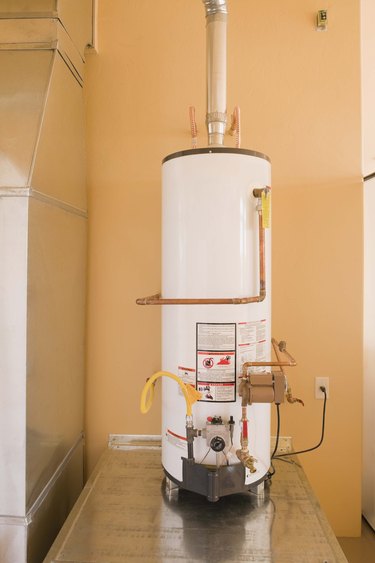Things You'll Need
Socket set 1/2" drive
Garden hose
Ball peen hammer

A rotten egg smell happens mostly to people who have well water. The reason this smell happens is because of the iron in the well water. Water heater manufactures do not make water heaters for well users. The odor happens when the iron in the water comes in contact with the aluminum anode rod in the tank. The purpose of the anode rod is to act as a sacrificial catcher of the impurities entering the tank and as it does that, it slowly dissolves. The rod is located on the top of the tank usually behind and between the hot and cold water supply.
Step 1
Install a sediment filter at the entry point of your water supply to limit the amount of iron entering. The average cost is $30.00 to $40.00 and will help by keeping faucet aerators cleaner.
Video of the Day
Step 2
Turn off the gas, turn the gas control valve to the pilot position and drain the water tank completely.
Step 3
Replace the aluminum anode rod with a magnesium anode rod at a cost of $20.00 to $30.00. The magnesium anode rod will not produce that terrible odor like the aluminum ones do. Some people remove the aluminum anode rod without replacing it. This is a bad idea and will accelerate the corrosion of the tank.
The warranty on your water heater is based on the thickness of the anode rod. On a 6 year warranty the anode rod is dissolved in the 5th year, on a 9 year tank in the 8th year and so on. If you read the manual in some cases it states that if you remove the rod the warranty is voided.
Step 4
Cleanse the tank. With the boiler drain valve at the bottom of the tank open, turn the water on in short spurts to flush as much of the iron sediment out of the bottom of the tank as possible. You may have to repeat this numerous times to flush as much as you can to clear the tank.
Step 5
Shut the bottom boiler drain valve, open the pressure relief valve to allow air to escape and at least one faucet so your water pipes don't fill with air, which will cause your faucets to sputter. Shut the pressure relief valve the minute you see water and then shut off the faucet.
Step 6
Turn on the gas and set the gas valve back to the on position.
Tip
Wait for the tank to cool down before working on it. Use a ball peen hammer with a short rap to loosen the nut.
Warning
If you are dealing with a gas appliance, you need to shut the gas off.
Video of the Day